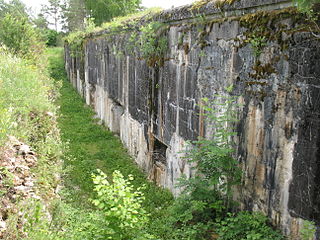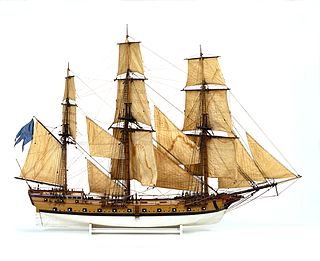
The Russo-Swedish War of 1741–1743 was instigated by the Hats, a Swedish political party that aspired to regain the territories lost to Russia during the Great Northern War, and by French diplomacy, which sought to divert Russia's attention from supporting its long-standing ally the Habsburg monarchy in the War of the Austrian Succession. The war was a disaster for Sweden, which lost more territory to Russia.

The Finnish War was fought between the Kingdom of Sweden and the Russian Empire from 21 February 1808 to 17 September 1809 as part of the Napoleonic Wars. As a result of the war, the eastern third of Sweden was established as the autonomous Grand Duchy of Finland within the Russian Empire. Other notable effects were the Swedish parliament's adoption of a new constitution and the establishment of the House of Bernadotte, the new Swedish royal house, in 1818.

The Russo-Swedish War of 1788–1790 was fought between Sweden and Russia from June 1788 to August 1790. The war was ended by the Treaty of Värälä on 14 August 1790 and took place concomitantly with both the Austro-Turkish War (1788–1791), Russo-Turkish War (1787–1792) and Theatre War. The war was, overall, mostly insignificant for the parties involved.

Field Marshal count Augustin Ehrensvärd was a Swedish military officer, military architect, artist, creator of the Suomenlinna (Sveaborg) fortress, Svartholm fortress and the Swedish archipelago fleet. He was born in Fullerö Castle, Barkarö and died in the village of Saris, Mynämäki.

The Suomenlinna Church in Helsinki, Finland, was built in 1854 as an Eastern Orthodox garrison church for the Russian troops stationed at the Suomenlinna sea fortress. The fortress comprises five islands joined together by bridges, and the church is the central feature on the island of Iso Mustasaari, located at its highest point. It is surrounded by other fortress buildings, but the old parade ground is immediately to the east, and a park lies immediately to the south. It is oriented southwest to northeast so that it would align with the Crownwork Ehrensvärd defense front located to the southwest of the church.

The First Battle of Svensksund, also known as the First Battle of Rochensalm from the Russian version of the Finnish: Ruotsinsalmi, was a naval battle fought in the Gulf of Finland in the Baltic Sea, outside the present-day city of Kotka, on August 24, 1789, during the Russo-Swedish War (1788–1790).

The Battle of Hogland was a naval battle that took place on 17 July [O.S. 6 July] 1788 during the Russo-Swedish War (1788–1790).

The Battle of Vyborg Bay was a naval battle fought between Russia and Sweden on 3 July 1790 in Vyborg Bay off the coast of Vyborg during the Russo-Swedish War (1788–1790). The Swedish Navy suffered heavy losses, losing seven ships of the line and three frigates, but Gustav III of Sweden eventually ensured a Swedish naval escape through a Russian naval blockade composed of units of the Baltic Fleet, commanded by Admiral Vasily Chichagov. British historians would later call the Battle of Vyborg Bay the "Baltic Trafalgar". The battle ranks among the world's largest historical naval battles and also among the most influential, as it introduced the naval battle concept of "firepower over mobility".

The siege of Sveaborg was a siege by Imperial Russian forces of the sea fort of Sveaborg, off the coast of Helsingfors (Helsinki); at the time Finland was part of the Kingdom of Sweden. It took place in the spring of 1808, during the Finnish War. Despite its formidable reputation as "the Gibraltar of the North", the fortress surrendered after a siege of two months. As its capitulation was followed by the rapid collapse of Swedish resistance elsewhere, and ultimately the Russian conquest of Finland, the siege is often regarded as the decisive battle of the war.

Peter the Great's Naval Fortress or the Tallinn-Porkkala defence station was a Russian fortification line, which aimed to block access to the Russian capital Saint Petersburg via the sea. The plans for the fortress included heavy coastal artillery pieces along the northern and southern shores of the Gulf of Finland. The emphasis was put on the defenses of the gulf's narrowest point, between Porkkala, and Tallinn,. This was a strategic point, as the two fortresses of Mäkiluoto and Naissaar were only 36 kilometres (22 mi) apart. The coastal artillery had a range of about 25 km (16 mi) and could thus "close" the gap between the shores, trapping enemy ships in a crossfire. Furthermore, a new major naval base was constructed in Tallinn.

The Svartholm fortress was built between 1749 and 1764 outside Loviisa in Southern Finland by Augustin Ehrensvärd. The fortress, which lies at the mouth of the Bay of Loviisa, along with the planned land fortress at Loviisa, would have prevented invading Russian forces from entering what was then Swedish territory in present-day Finland.

Kuninkaanportti or Kungsporten is the principal entrance to the fortress Suomenlinna outside Helsinki. It is on the southernmost island of Suomenlinna, in front of the Kustaanmiekka strait, and is considered the main symbol of Suomenlinna.

The Krepost Sveaborg was an Imperial Russian system of land and coastal fortifications constructed around Helsinki during the First World War. The purpose of the fortress was to provide a secure naval base for the Russian Baltic fleet and to protect Helsinki and block routes to Saint Petersburg from a possible German invasion. Krepost Sveaborg was part of Peter the Great's Naval Fortress, a coastal fortification system protecting access to Saint Petersburg by sea. The central part of Krepost Sveaborg was the old fortress of Suomenlinna where the fortress headquarters were located. Due to technological advances in artillery the old fortress was no longer capable of providing a sufficient protection, and a new main defensive line was built well beyond the old fortress boundaries. New coastal artillery guns built on outlying islands protected Krepost Sveaborg from the sea, while fortified lines constructed around Helsinki were intended to stop any attacks on land. The primary coastal guns were 10 in (254 mm) model 1891 guns and 6 in (152 mm) model 1892 Canet guns. Older 11 in (279 mm) model 1877 guns were also used. In summer 1917 the fortress had two hundred coastal or anti-landing guns, of which 24 were 10-inch guns in six batteries, 16 were 6-inch Canet guns in four batteries and twelve were 11-inch guns in three batteries. The artillery used in land fortifications included older coastal guns, old fixed carriage guns and newer light field guns. In March 1917, Krepost Sveaborg had a total of 463 guns, although many of them were obsolescent. Krepost Sveaborg was still partly incomplete in 1917 when the February Revolution halted most of the construction work. Some further construction work was carried out during the remaining year, but all work halted during the October Revolution. Following the Finnish Declaration of Independence, parts of the land fortifications were used in the Finnish Civil War. The coastal fortifications were later taken over by Finland to protect Helsinki, while the land fortifications were mostly abandoned and disarmed.

Ruotsinsalmi sea fortress is a fortification system in Kotka, Finland. It is part of the South-Eastern Finland fortification system built by Russia after Russo-Swedish War of 1788-1790. Ruotsinsalmi sea fortress formed the southern part of a double fortress together with Kyminlinna and it was built to counter the Swedish sea fortresses of Svartholm in Loviisa and Sveaborg (Suomenlinna) in Helsinki. Ruotsinsalmi also acted as an outpost of the Kronstadt sea fortress in Saint Petersburg. During the Crimean War, a British-French fleet destroyed the Ruotsinsalmi fortifications in 1855.

A turuma was a type of warship built for the Swedish archipelago fleet in the late 18th century. It was specifically developed for warfare in the Archipelago Sea and along the coasts of Svealand and Finland. The turuma was designed by the prolific naval architect Fredrik Henrik af Chapman for use in an area of mostly shallow waters and groups of islands and islets that extend from Stockholm all the way to the Gulf of Finland.

A hemmema was a type of warship built for the Swedish archipelago fleet and the Russian Baltic Fleet in the late 18th and early 19th centuries. The hemmema was initially developed for use against the Imperial Russian Navy in the Archipelago Sea and along the coasts of Svealand and Finland. It was designed by the prolific and innovative Swedish naval architect Fredrik Henrik af Chapman (1721–1808) in collaboration with Augustin Ehrensvärd (1710–1772), an artillery officer and later commander of the Swedish archipelago fleet. The hemmema was a specialized vessel for use in the shallow waters and narrow passages that surround the thousands of islands and islets extending from the Swedish capital of Stockholm into the Gulf of Finland.

The archipelago fleet, officially the "fleet of the army", was a maritime branch of the Swedish Armed Forces which existed between 1756 and 1823. Its purpose was to protect the coasts of Sweden, which was surrounded by a natural barrier of archipelagoes. Throughout its existence, the fleet was a largely independent arm of the Swedish Army, separate from the Swedish Navy, with the exception of a few years in the late 1760s. In a number of respects, it was a precursor of the Swedish Coastal Artillery and its coastal fleet.

The Åland War was the operations of a Anglo-French naval force against military and civilian facilities on the coast of the Grand Duchy of Finland in 1854–1856, during the Crimean War between the Russian Empire and the allied France and Britain. The war is named after the Battle of Bomarsund in Åland. Although the name of the war refers to Åland, skirmishes were also fought in other coastal towns of Finland in the Gulf of Bothnia and the Gulf of Finland.

The Ehrensvärd grave is the final resting place and memorial of Augustin Ehrensvärd, the founder of the Suomenlinna island fortress in Helsinki, Finland, at the Linnanpiha yard on the island of Susisaari in Suomenlinna. Ehrensvärd was buried at the yard in 1783 but the memorial was only completed in its current form in 1805.

Suomenlinna is a village-like district of the city of Helsinki, Finland with about 700 inhabitants. Its best known part is the maritime fortress of Suomenlinna.



































